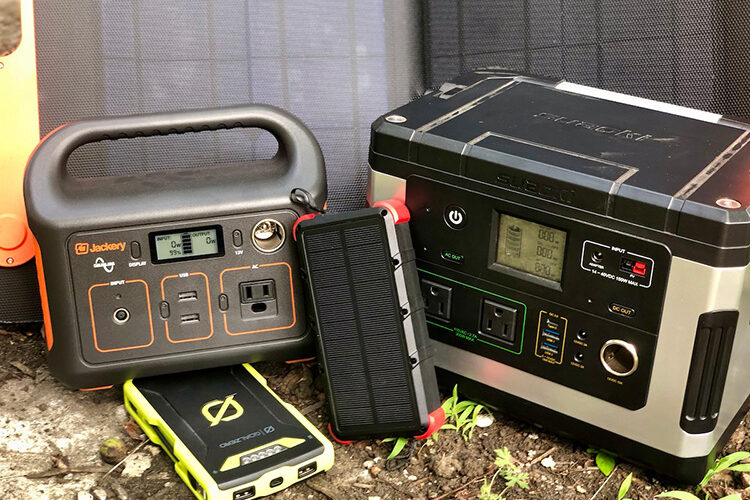There once was a time when carrying electronic devices with us into the great outdoors was pretty much unthinkable. Fragile and expensive, such devices offered few benefits to campers and backpackers, especially those interested in going ultralight. But times have changed and now it is not uncommon to take a host of gadgets with us when hitting the trail or simply car camping for the weekend with the family. Everything from smartphones and tablets, to headlamps and GPS trackers are powered by rechargeable batteries these days and keeping them functioning can be a real challenge.
Fortunately, there are now a number of great solutions available for charging our electronic equipment while on the go. So, whether you’re heading out for just the day or for weeks at a time, these are the best ways to prevent your devices from running out of juice and becoming nothing more than dead weight in your pack.
Even if you’re just going out for day hike, it is always a good idea to take a portable battery pack with you just in case. Sometimes you find yourself hiking for far longer than you expected and the last thing you want is for your smartphone or rechargeable headlamp to die on you just when you need it most.
There are literally dozens of compact battery packs to choose from, but if you’re going to be spending a considerable amount of time in the outdoors, you’ll want one that is rugged and built to withstand the elements.
Lifeproof’s LifeActive Power Pack ($79.99) fits that description nicely, offering enough power to recharge an iPhone more than three times and featuring a durable case that is both water and drop-proof. The LifeActive includes a quick-charging USB port for rapid refills and bright LED lights that allow it to be used as a flashlight or emergency flasher, too.
Quick Tip: Cold conditions can kill rechargeable batteries very quickly. To help prevent this from happening, keep your smartphone and other devices in an inner pocket inside your jacket during the day or in the foot of your sleeping bag at night when temperatures take a plunge.
If you are camping or traveling for a few days at a time, a higher capacity battery pack is likely in order. On longer getaways you’re more likely to be carrying extra electronic gear with you, such as a camera, GPS device, or Bluetooth speaker. You’ll also need to keep your smartphone running for extended periods of time too, which can be a challenge in and of itself.
The RAVPower Exclusives Solar Power Bank ($52.99) stores enough energy to recharge a smartphone as many as ten times and it comes with a built-in flashlight too. It is also dust, drop, and waterproof, has multiple USB in and out ports for rapid recharging, and is equipped with its own solar panel to help keep its internal battery topped off as well.
An extended camping trip lasting a week or longer could involve a considerable amount of electronic gear. Not only will smartphones, cameras, and GPS devices be a part of the mix, but tablets, laptops, and even drones may come along for the journey too.
In those circumstances, you’ll need a much larger power source, typically moving away from compact battery packs in favor of portable power stations instead. What these devices lack in portability they make up for with batteries that are much higher in capacity. They’ll also offer more options when it comes to charging ports too.
The Jackery Explorer 240 ($230) is a great choice when choosing this type of portable power station, bringing a nice mix of size, capacity, and charging options. With 240 watt-hour of battery life it can recharge an iPhone more than 15 times, or a laptop as many as 2-4 times.
And since it features an AC wall outlet built right in, it can be used to power just about anything, from LCD televisions to small appliances. It also includes two quick-charging USB ports and a 12-volt DC port too. On top; of that, it can even be recharged in the field using Jackery’s 50-watt solar panel.
Quick Tip: To get maximum efficiency from a solar panel, lay the device flat and in direct sunlight. You may have to adjust its position throughout the day to collect as much light as possible.
For those who spend extended periods of time in the backcountry and need power in a base camp setting, a larger power station is likely in order. Not only will you need more capacity, you’ll definitely want more charging ports and outlets too.
Compatibility with a solar panel is a must too since you’ll need a way to recharge the power station over an extended period of time. With the right set-up, you could theoretically stay off the grid indefinitely and keep your electronic gear charged the entire time.
For these long-term needs, Goal Zero’s Yeti 1000 Lithium is the perfect choice. Not only does it offer more than 1000-watt hours of power, but it includes two AC wall outlets, a 12-volt DC port, and four USB ports, all in a package that weighs just 40 pounds. It is also compatible with the company’s Boulder 100-watt portable solar panel for convenient charging anywhere.








